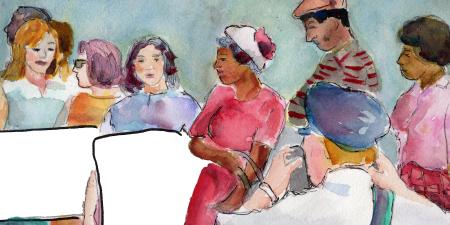Abstract
Following the US Civil War, newly freed Black Americans had significantly poorer health than Whites. Founded in 1865, the Freedmen’s Bureau offered a range of support (eg, food, health care, shelter, legal aid) to try to improve health among the newly freed. The COVID-19 pandemic has exposed the persistence of racial health inequity in American life. Ethical obligations to address it exist now, just as they did in 1865.
Efforts to Reduce Health Inequities Have a Long History
In 1992, the British scholar Margaret Whitehead defined health inequities as health differences that are avoidable, unnecessary, and unjust.1 Her definition is central to understanding that inequities are not inevitable and that, if they are preventable, then an ethical framework for their elimination can be assumed. Public health seeks to improve health and prevent disease and, as such, plays an essential role in the ethical quest to eliminate health inequities. In the United States, organized efforts to improve the health of and address health inequities in the African American population go back to at least the end of the Civil War. This article examines the nation’s quest to improve the health of minorities in the Reconstruction period and in the late 20th century and early 21st century.
Reconstruction
On March 3, 1865, Congress enacted legislation to establish a Bureau for the Relief of Freedmen and Refugees, commonly known as the Freedmen’s Bureau (see Figure).2 This agency was founded at the request of President Abraham Lincoln as a way to integrate the recently freed slaves into the fabric of American society. It was felt that affirmative assistance was required to educate, feed, settle, and economically empower the individuals and families of these recently freed Black slaves and poor Whites after the Civil War. In addition, the bureau was charged with providing emergency and temporary health care until state and local authorities could assume this responsibility because of the significantly poor health of these newly freed citizens.3 High rates of infectious diseases, such as tuberculosis and smallpox, high infant mortality, severe malnutrition, and unaddressed injury were well documented. Despite its efforts during its 7-year existence, the bureau never fully fulfilled its mission because of continued underfunding, political resistance,3 and overt racism that was the hallmark of Southern resentment during the Reconstruction period.
Figure. Chap XC—An Act to Establish a Bureau for the Relief of Freedmen and Refugees
|
Be it enacted by the Senate and House of Representatives of the United States of America in Congress assembled, That there is hereby established in the War Department, to continue during the present war of rebellion, and for one year thereafter, a bureau of refugees, freedmen, and abandoned lands, to which shall be committed, as hereinafter provided, the supervision and management of all abandoned lands, and the control of all subjects relating to refugees and freedmen from rebel states, or from any district of country within the territory embraced in the operations of the army, under such rules and regulations as may be prescribed by the approved by the President… APPROVED, March 3, 1865 Source: Freedman and Southern Society Project, University of Maryland.2 |
From today’s vantage point, this was one of the first efforts of affirmative action in the nation, whereby social factors were recognized as important determinants of the ability of individuals to prosper in our society. The potential improvement of the health of African Americans from broad societal interventions like those the Freedmen’s Bureau was charged with implementing were later recognized and promoted by W.E.B. Du Bois. In 1906, Du Bois published one of the earliest descriptions of health disparities between Blacks and Whites and their relation to social conditions in The Health and Physique of the Negro American: Report of a Social Study Made Under the Direction of Atlanta University: Together with the Proceedings of the Eleventh Conference for the Study of the Negro Problems.4
Late Twentieth Century
The nation has continued to struggle with both the recognition of and the ability to eliminate these health disparities. In 1985, the US Secretary of Health and Human Services, Margaret Heckler, released a report authored by the agency’s Task Force on Black and Minority Health.5 This report, now known as the “Heckler Report,” resulted in several actions being taken to address this issue in modern times. One of the most consequential actions was the creation of the Office of Minority Health within the Department of Health and Human Services to better coordinate efforts across the department and to provide national leadership to reduce health disparities.6 This office continues to coordinate the nation’s efforts to improve the health of racial and ethnic minorities.
Eighteen years later, in 2003, the Institute of Medicine of the National Academies released a consensus report titled Unequal Treatment: Confronting Racial and Ethnic Disparities in Health Care, which documented that inequities in the quality of health care received by racial and ethnic minorities persist even after accounting for socioeconomic conditions.7 The report made several recommendations to improve the clinical encounter to address these health care disparities, including making physicians aware of the potential for unconscious bias in clinical practice, improving education to enhance cultural competency in medical practice, and standardizing data collection to improve the understanding of disparities and to craft potential solutions.
Health inequities occur for 4 basic reasons: unequal access to health care (eg, lack of or inadequate health insurance coverage and access to clinicians and services), differences in the quality of care received in the health system, differences in individual health behaviors (eg, use of tobacco, physical inactivity, and poor nutrition influenced by a variety of individual, community, and other societal factors),and differences in social determinants that influence health (eg, dangerous occupation, unsafe or unaffordable housing, lack of quality education, environmental exposures, low income, poor community safety, and racism).8,9,10,11 During the COVID-19 pandemic, many of these social factors played an important foundational role in the observed inequities in morbidity and mortality for communities of color.
COVID-19 Health Inequity
The People’s Republic of China identified a cluster of individuals with severe viral pneumonia, two-thirds of whom had been exposed to a seafood market in the capital city Wuhan in Hubei province in December 2019.12 By late January 2020, more than 800 confirmed cases had been identified in Wuhan,11 and by the first week of April, roughly 1.3 million cases had been reported worldwide.12,13 The spread of this virus, which was later named SARS-CoV-2, led to a worldwide pandemic of the disease we now know as COVID-19. This pandemic was not only a major public health phenomenon but also threatened to cause the worst economic downturn since the Great Depression of 1929.
Like many major health and economic events, this pandemic did not affect all populations equally. In the United States, COVID-19 caused health effects that were disproportionately more severe in African Americans and Hispanics than in non-Hispanic Whites.13,14 Several reasons have been proposed for this disparity. First, the risk of increased exposure was higher for certain occupations than others.15 Within these higher-risk groups, minorities were more prevalent in those occupations that are public facing and also less likely to be able to telework both in the early phase of the epidemic and later during the lockdown. Workers in jobs such as meat or poultry plants, public transit, grocery stores, or service industries were considered essential workers. Second, members of these populations are more susceptible to severe COVID-19 should they get infected. In the United States, African Americans ages 18 to 49 are almost twice as likely as Whites to die from heart disease, stroke, and diabetes.16 Therefore, if they are infected by SARS-CoV-2, they are more likely to have a severe clinical course and a higher mortality rate.17 These findings are consistent with the experience in China, where the fatality rate was higher among people who had the same chronic diseases.18 The 2 major determinants of health disparities in this pandemic were therefore highly influenced by occupation and preexisting chronic disease burden. Additionally, early evidence is emerging that other social determinants played a role as well, including higher rates of poverty, higher household crowding, and higher racialized economic segregation.17,19 In what follows, I discuss 3 additional factors that have contributed—or may contribute—to health disparities related to COVID-19.
Like many major health and economic events, this pandemic did not affect all populations equally.
Misinformation. Throughout the early months of the outbreak, misinformation in communities of color flourished through both word of mouth and the internet. One such false belief that was prevalent among African Americans was they did not need to worry about catching the disease because they were immune. While this is certainly not true, early reports concerning affected individuals did not include data by race and ethnicity, and early reports that did not include reported cases in Africa are believed to have supported these early views. In addition, a campaign of disinformation targeting communities of color and others, instigated by individuals whose goals remain unclear, reinforced the immune theory and propagated rumors of false cures as well. Such disinformation has been demonstrated in the past to undermine trust in vaccines.20 On the ground, flyers encouraged minorities not to participate in testing or gave false information on what to do if one becomes infected with SARS-CoV-2 and gets COVID-19.21 One authoritative-looking infographic found on social media intentionally promoted purposely going into the community, which would of course infect other people and give them COVID-19.21
Testing. As the outbreak progressed, concerns arose about equal access to the diagnostic test for the SARS-Cov-2 virus. Overall, the availability of testing was highly limited because of the national shortage of test materials and supplies. Access was also limited because of the initial placement of testing facilities in locations that were difficult for many people to get to. Examples include using drive-through testing facilities that were difficult to get to for individuals without cars or who were reliant on public transportation. In addition, the hours of operation of some sites coincided with the times of day that shift workers typically work. Early recommendations for testing were also confusing and resulted in people without a clinician being given little opportunity to receive testing. The messages were confusing because people were initially given several places to go for testing where the test was not actually available, and the initial criteria for testing were often not clearly articulated.22
Populations without health insurance coverage were initially disadvantaged in accessing tests, as the initial strategy for testing was based on clinical indicators and severity of disease, which left many individuals with mild symptoms and poor access to health care undiagnosed. The CARES Act, signed into law in March 2020, provided some financial relief for testing, as it required most insurance plans to provide coverage without cost sharing for diagnostic COVID-19 testing.23 In addition, public health departments generally provided diagnostic testing as a public service without cost. However, as with most of these screening funding programs, the cost of associated medical care might not be covered for those without adequate health insurance. Even as testing has become more available, it remains unclear if equal access to testing has been achieved.
Reporting of COVID testing and clinical data initially was slow and inadequate, a testament to both the antiquated national data reporting systems in the United States and the apparent initial lack of interest in getting and reporting data by race and ethnicity.24 This lack of reliable data impeded the confirmation of health disparities early in the COVID-19 pandemic24 and may have delayed the targeting of public health education and prevention efforts to at-risk communities.
Research. The COVID-19 pandemic has resulted in a robust research effort to find effective therapies, marshal improvements in clinical care management, and find a safe and effective vaccine for SARS-CoV-2. Like most research endeavors, the inclusion of adequate numbers of women and minorities in the full range of clinical trials is challenging. Not having a diverse research population can result in adverse outcomes if a vaccine or other therapeutic is rushed into production without adequate evaluation of its impact on people of various race, ethnicities, or genders. While race and ethnicity are imperfect factors for inclusion in clinical trials, intrinsic and extrinsic factors associated with race and ethnicity that affect pharmacodynamics and pharmacokinetics must be considered in planning vaccine and therapeutic clinical trials. Factors such as access to health care, exposure to the disease, and disease susceptibility have been shown to result in disparities in vaccine uptake in previous infectious outbreaks similiar to SARS-CoV-2. The 2009-2010 H1N1 swine flu is one such example.25 There are also concerns about equal access to a SARS-Cov-2 vaccine once one becomes available. Ensuring adequate information about how it will be distributed, its ultimate price, and who pays for it are yet to be determined.
Conclusion
The inequities in disease burden and access to care experienced by racial and ethnic minorities during the COVID-19 pandemic raise important questions concerning the need to proactively anticipate and address the health impact of COVID-19 on underserved communities. The underlying health inequities and high prevalence of chronic diseases in these communities were a predictable risk factor that should have been included in pandemic plan implementation. The initial testing response was also not designed to rapidly identify this high-risk population.
The great COVID-19 pandemic will go down as a significant society-altering event. It had a major impact on both the health and the economic well-being of people all over world. It also revealed the persistent inequities in American society, particularly in health status. The United States has been on a quest to improve the health of minorities for over 150 years. COVID-19 demonstrates that significant work remains to be done to finish the mission the Freedmen’s Bureau was slated to address in 1865.
References
- Whitehead M. The concepts and principles of equity and health. Int J Health Serv. 1992;22(3):429-445.
-
Law Creating the Freedmen’s Bureau: CHAP XC.–An Act to Establish a Bureau for the Relief of Freedmen and Refugees. Freedmen and Southern Society Project, University of Maryland. Revised August 3, 2020. Accessed August 2, 2020. http://www.freedmen.umd.edu/fbact.htm
-
Peirce PS. The Freedmen’s Bureau: A Chapter in the History of Reconstruction. Iowa City, IA: State University of Iowa; 1904.
-
Du Bois WEB. The Health and Physique of the Negro American: Report of a Social Study Made Under the Direction of Atlanta University, Together With the Proceedings of the Eleventh Conference for the Study of the Negro Problems, Held at Atlanta University, on May the 29th, 1906. Atlanta University Press; 1906. Atlantic University publications 11.
-
Task Force on Black and Minority Health, US Department of Health and Human Services. Report of the Secretary’s Task Force on Black and Minority Health. Vols 1-8. Washington, DC: US Department of Health and Human Services; 1985-1986.
-
Gracia JN. Remembering Margaret Heckler’s commitment to advancing minority health. Health Affairs Blog. November 16, 2018. Accessed December 8, 2020. https://www.healthaffairs.org/do/10.1377/hblog20181115.296624/full/
-
Smedley BD, Stith AY, Nelson AR, eds; Institute of Medicine. Unequal Treatment: Confronting Racial and Ethnic Disparities in Health Care. National Academies Press; 2003.
- Dubowitz T, Heron M, Basurto-Davila R, Bird CE, Lurie N, Escarce JJ. Racial/ethnic differences in US health behaviors: a decomposition analysis. Am J Health Behav. 2011;35(3):290-304.
- Stimpson JP, Ju H, Raji MA, Eschbach K. Neighborhood deprivation and health risk behaviors in NHANES III. Am J Health Behav. 2007;31(2):215-222.
- Chuang YC, Cubbin C, Ahn D, Winkleby MA. Effects of neighborhood socioeconomic status and convenience store concentration on individual level smoking. J Epidemiol Community Health. 2005;59(7):568-573.
- Trim RS, Chassin L. Neighborhood socioeconomic status effects on adolescent alcohol outcomes using growth models: exploring the role of parental alcoholism. J Stud Alcohol Drugs. 2008;69(5):639-648.
- Huang C, Wang Y, Li X, et al. Clinical features of patients infected with 2019 novel coronavirus in Wuhan, China. Lancet. 2020;395(10223):497-506.
- Garg S, Kim L, Whitaker M, et al. Hospitalization rates and characteristics of patients hospitalized with laboratory-confirmed coronavirus disease 2019—COVID-NET, 14 states, March 1-30, 2020. MMWR Morb Mortal Wkly Rep. 2020;69(15):458-464.
- Kirby T. Evidence mounts on the disproportionate effect of COVID-19 on ethnic minorities. Lancet Respir Med. 2020;8(6):547-548.
- Groenewold MR, Burrer SL, Ahmed F, Uzicanin A, Free H, Luckhaupt SE. Increases in health-related workplace absenteeism among workers in essential critical infrastructure occupations during the COVID-19 pandemic—United States, March-April 2020. MMWR Morb Mortal Wkly Rep. 2020;69(27):853-858.
- Cunningham TJ, Croft JB, Liu Y, Lu H, Eke PI, Giles WH. Vital signs: racial disparities in age-specific mortality among blacks or African Americans—United States, 1999-2015. MMWR Morb Mortal Wkly Rep. 2017;66(17):444-456.
- Webb Hooper M, Nápoles AM, Pérez-Stable EJ. COVID-19 and racial/ethnic disparities. JAMA. 2020;323(24):2466-2467.
- Wu Z, McGoogan JM. Characteristics of and important lessons from the coronavirus disease 2019 (COVID-19) outbreak in China: summary of a report of 72 314 cases from the Chinese Center for Disease Control and Prevention. JAMA. 2020;323(13):1239-1242.
-
Chen JT, Waterman P, Krieger N. COVID-19 and the unequal surge in mortality rates in Massachusetts, by city/town and ZIP code measures of poverty, household crowding, race/ethnicity and racialized economic segregation. Harvard Center for Population and Development Studies Working Paper Series. 2020;19(2):1-9. Accessed May 25, 2020. https://tinyurl.com/y7qzot3l
- Broniatowski DA, Jamison AM, Qi S, et al. Weaponized health communication: Twitter bots and Russian trolls amplify the vaccine debate. Am J Public Health. 2018;108(10):1378-1384.
-
Office of Homeland Security and Preparedness; Office of Emergency Management. State of New Jersey Rumor Control and Disinformation COVID-19. Accessed September 1, 2020. https://static1.squarespace.com/static/54d79f88e4b0db3478a04405/t/5e7cd81ccad1f3469d0a6d62/1585240092953/COVID-19_Disinformation_False+Infographic_%2803-26-2020%29.png
-
Artiga S, Corallo B, Pham O. Issue brief: racial disparities in COVID-19: key findings from available data and analysis. Kaiser Family Foundation. August 17, 2020. Accessed September 21, 2020. https://www.kff.org/report-section/racial-disparities-in-covid-19-key-findings-from-available-data-and-analysis-issue-brief/
-
CARES Act, S 3548, 116 Cong, 2nd Sess (March 19, 2020).
-
Krieger N, Testa C, Chen JT. US racial/ethnic data for COVID-19 cases: still missing-in-action. Harvard Center for Population and Development Studies Working Paper Series. 2020;20(1):1-3. https://cdn1.sph.harvard.edu/wp-content/uploads/sites/1266/2020/09/20_krieger-et-al_covid-19-and-missing-data-on-race_ethnicity_final_Vol-20_No-1_with-supplemental-material.pdf
- Quinn SC, Kumar S, Freimuth VS, Musa D, Casteneda-Angarita N, Kidwell K. Racial disparities in exposure, susceptibility, and access to health care in the US H1N1 influenza pandemic. Am J Public Health. 2011;101(2):285-293.



